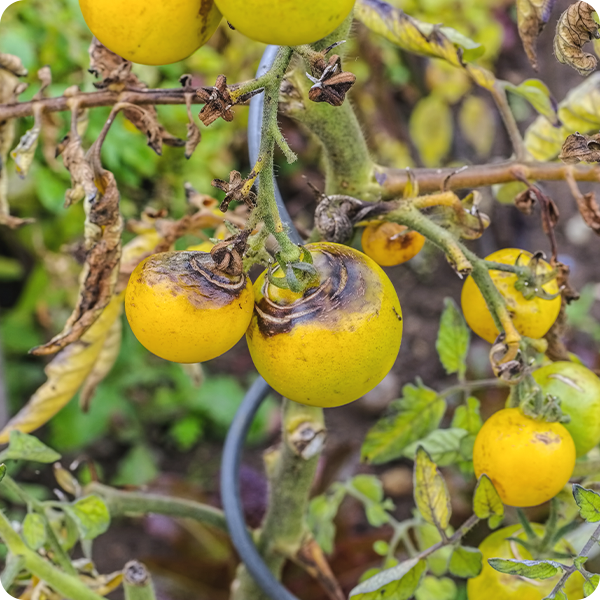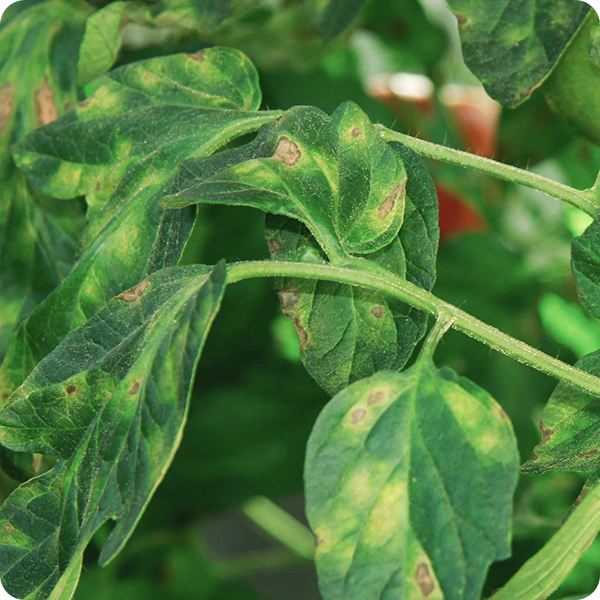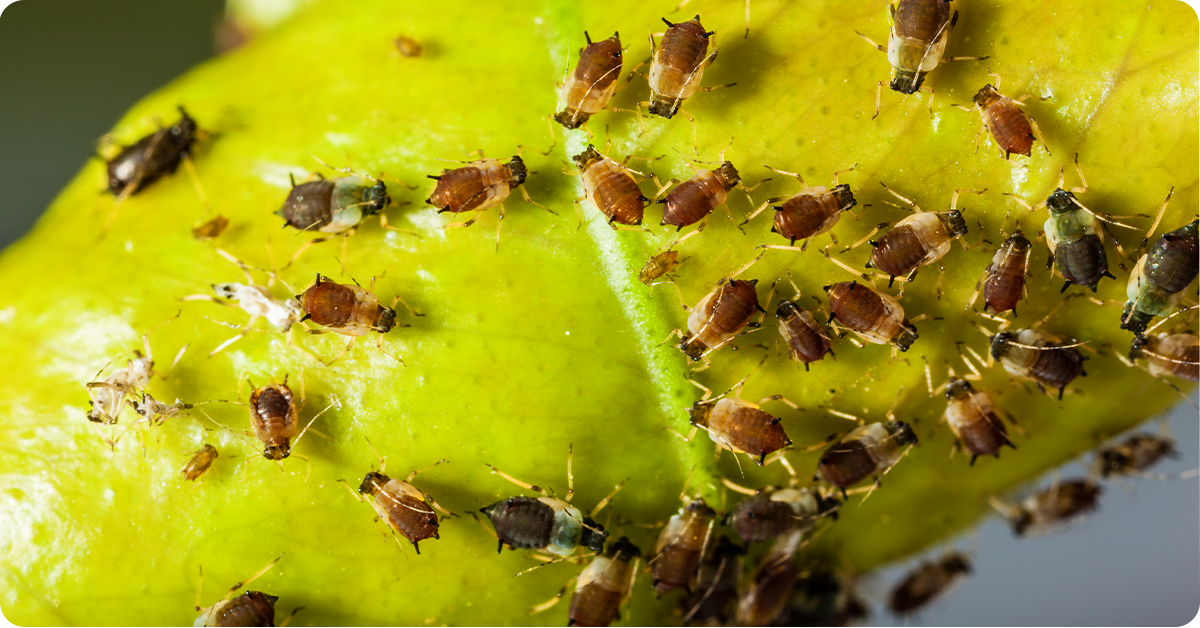
Spring and early summer is an exciting time for the gardener. Seeds are sprouting, transplants are beginning to establish themselves, and the garden–your investment in sweat and time–is taking off.
While walking through the garden, you may at some point discover yellow leaves on the plants. The leaves can tell a story, and when they’re yellowing, the plant isn’t producing enough chlorophyll. As you dig deeper, the leaves can also tell you why.
Lean in and take a closer look at your plant and the soil around it. Among other issues, you may notice pests getting started, or determine whether it’s receiving too much or too little water. With close observation, you can pinpoint and treat the likely problem.
What are 8 reasons plant leaves turn yellow? What can help correct each issue, and keep your plant and garden thriving?

1. Overwatering
Watering issues are generally the most common cause of yellowing leaves. When your plants are overwatered, the performance and vigor decrease. Oxygen is being pushed out of the soil, and the roots are simply “under aired” and suffocating. With little air, the roots will begin to drown and rot. Overwatering also leads to various fungal diseases.
Check the moisture level in the soil. Dig down a few inches near the stem of the plant. Take a small handful of soil and squeeze it. If it’s moist or cool to the touch, it doesn’t need more water at the moment.
Signs of Overwatering
The mature leaves on overwatered plants are brownish-yellow and begin to wilt, look limp, or have a mushy feel. Black spots and lumps may appear on the stem and leaves of the plant, and the fruit will crack due to too much water.
Treatment for Overwatered Plants
First, reduce the watering frequency. Water deeper and less often. Also add air to the soil by poking holes deep around the root zone with a screwdriver. If your plants are in a container, drill a hole in the bottom of the pot and make sure the soil drains well.

Check out our lawn watering guide for more best practices and tips
2. Dehydration
While overwatering plants is just as harmful, underwatering will sometimes kill your plants much faster. Dehydrated plants look “off” and lack vigor. Performance declines with under watered plants, and fruit may not form properly.
Plants normally wilt during the heat of the day because they get hot and they can’t move out of the sun. To determine if your plants aren’t receiving adequate water, check the soil a few inches below the surface either in the morning or in the early evening. If it feels warm or dry to the touch, it needs water.
When you work out a proper watering schedule, keep in mind the proper amount of water varies based on climate, month, and temperature. Continue to monitor your plants and check soil moisture levels throughout the growing season.
Signs Your Plants are Dehydrated
The newest, youngest leaves are wilting and turning yellow. With tomatoes, the plants may develop blossom-end rot.
How to Treat Dehydrated Plants
Water deeper and less often. Plants benefit from deep watering rather than frequent light waterings. In fact, they prefer a good drink as opposed to a light shower. This encourages the roots to grow deeper, enabling the plant to access more nutrients in the soil and not dry out as quickly.

3. Cold Stress
Shifts in temperature–hot or cold–affects the health and color of leaves as well. When prolonged cool temperatures or late spring cold drafts occur, your plants–especially tender vegetable plants such as tomatoes and cucumbers–may lose their color.
Keep an eye on evening temperatures as well. When a late frost is forecasted, cover your plants for the night.
Signs of Cold Stress
Yellowing leaves, and in some cases, the edges appear burned.
How to Treat Cold Stressed Plants
Patience and time will solve most issues. Good sunny days will bring your plants back to life and chlorophyll will return to the leaves. In case of frost, use a frost blanket or bucket to cover your plants in the evening.

4. Sunlight
Yellow leaves appear when the plant receives too little sunlight, and with partial shade varieties, too much sunlight. Leaves are the solar panels of the plant; the place where their energy is produced.
When a plant becomes thick and bushy, it sometimes blocks light from reaching inner and lower leaves. These leaves cannot photosynthesize and chlorophyll production comes to a halt. Since the leaves are non-productive, the plant no longer needs them.
Partial shade plants and cole crops such as lettuce are susceptible to burning and turning yellow in the hot summer months. It’s best to plant these veggies (or flowers) in early spring or fall, or in partly shaded areas. However, if they're already growing strong, try to give them a break from direct sunlight in the heat of the day.
Signs of Sunlight Problems
Yellowing leaves on the bottom or inside of a usually thick plant. In cases of heat stress, leaves will yellow and burn in spots.
Treatment
Simply remove non-productive yellowing leaves. The plant will be fine without them. On plants that don’t perform well in direct sunlight, screen them in the mid-afternoon to prevent burning. If they’re in a pot or container, move them to a more shady part of the yard when outside temperatures begin to soar.
5. Nutrient Deficiencies
One common reason a plant's leaves turn yellow is the lack of essential nutrients in the soil. Plants lacking these minerals show different symptoms, but in general, they are off-color, lack vigor, or simply, not growing well.
Essential minerals are absorbed through the soil, and different plants have different nutrient requirements. Know what each of your plants need, and test your soil regularly to make sure it contains the right amount.
Deficiency Signs and Treatments for 6 Essential Nutrients

Calcium Deficiency
Signs: Leaves are yellow, and distorted with a “crisp” feel. With tomatoes, the plants may develop blossom-end rot.
Treatment: Test the soil and add lime if it’s acidic or gypsum if it’s alkaline. Alkaline soils are more common than acid soils in the Intermountain West.

Iron Deficiency
Signs: Leaves typically become chlorotic; yellow in color with green veins. Plant growth is stunted and it’s usually first noticed on new growth.
Treatment: Test the soil pH level and lower it under 7.

Nitrogen Deficiency
Signs: Pale yellow leaves on new growth (usually at the top of the plant). It begins with the center vein and tips turning yellow first, and plant growth is usually stunted as well.
Treatment: Add manure-based compost or used coffee grounds to the soil.

Magnesium Deficiency
Signs: Leaves yellow with white stripes along still green veins. It usually first appears on lower limbs.
Treatment: Add compost or fertilizer rich in magnesium sulfate (commonly known as Epsom salts) to the soil.

Potassium Deficiency
Signs: Leaf edges and tips yellow, and mature leaves may develop brown spots or yellow-brown veins.
Treatment: Add fruit and veggie rich compost to the soil, or bury citrus rinds at the base of the plant. A potassium specific fertilizer may be used as well.

Zinc Deficiency
Signs: Leaves appear lighter and discolored in-between large veins.
Treatment: Spray with kelp extract, or apply a fertilizer containing zinc.
How to Prevent Nutrient Deficiencies
Always work to improve the health of your soil. Mix compost and soil conditioners into the soil in the spring or fall, and add humate throughout the year. Turn it under the soil 4-6 inches. If it’s during the growing season, add it in-between rows and plants by scratching and mixing the top 2-3 inches with a long handled 3-prong cultivator. Also rotate your crops each year to help prevent pests and diseases, and to maintain a rich, fertile, growing environment for your plants.
Each individual nutrient deficiency may require a specific type of treatment (as noted above). Remember, test the soil to find the exact issue, and treat appropriately. When you treat with fertilizer, apply it directly to the soil as directed on the label so your plant can absorb the right amount of the nutrients it needs.
In general, we recommend adding a balanced nutrient fertilizer in the beginning of the growing season such as IFA Grand Champion All-Purpose Fertilizer (16-16-16). It contains the essential macronutrients along with minor nutrients like iron, magnesium, zinc, and many micronutrients to help provide your garden a fertile base throughout the season.
IFA Premium Garden Fertilizer (16-16-8) is a great option as well. Once your vegetable or flowering plants are well established, supplement the soil with Fertilome Blooming & Rooting Plant Food (9-58-8) to help produce more blooms and a heavier crop of fruit.

6. Over Fertilization
The garden doesn’t perform well when it lacks essential nutrients, but keep in mind, your plants can be overfed too. More is not always better. When the soil is over fertilized, the plants have difficulty absorbing all it needs and the pH level may sometimes change.
Signs Your Plant Has Too Much Fertilizer
Leaves turn yellow or brown, dry out, and commonly fall down. More specifically with nitrogen, a plant with too much will grow an abundance of branches and leaves with little to no fruit production.
Treatment for Over Fertilizing
You could test your soil before applying any fertilizer. It’s not necessary, but it can help you start down the right path to determine what your soil needs and make a plan.

7. Fungal or Viral Disease
The leaves on your plants may also turn yellow and display additional symptoms if it has been infected with a fungal or viral disease. The signs and treatments vary depending on the disease type. You may even see various degrees of development. This helps you determine that it’s likely a disease.
Signs and Treatment for 3 Common Diseases:
 |
Curly TopThis virus, carried by the beet leafhopper, causes leaves to turn upward and yellow, purple-colored veins, premature fruit and stunts growth. |
 |
Early BlightYour plant starts to show brown spots, then the leaves turn yellow and fall off. |
 |
Septoria Leaf SpotHigh humidity, high temperatures and overhead watering can cause lower leaves to develop dark brown circular spots with a yellow ring. It’s one of the most destructive fungal diseases on tomato foliage and usually appears after the first fruit sets. |
How to Prevent Fungus and Viral Disease
Water properly to help prevent many fungal diseases. Avoid overhead watering and watering too much. Use either drip, furrow or flood irrigation, and soak thoroughly on a consistent basis rather than giving your plants a light sprinkling every day. This will encourage a healthy, deep root system.

8. Pests
Along with beet leafhoppers, there’s a number of additional pests infesting our gardens. Aphids, mites, earwigs, mealybugs, thrips, scale, or whiteflies–amongst many others–are all typically found around our fruits, flowers and vegetables.
Signs of Plant Pests
The damage and symptoms shown by your plants may vary depending on the type of pest, but yellowing leaves are a common sign of most. Once you notice a problem, first find and identify the insect causing issues. When you’re closely observing your plants, peek on top and below the leaves. Look for additional symptoms, insects, and possibly, eggs. Also check darker, cooler areas such as under your lettuce. Earwigs and other bugs love to hang out in these places.
Treating and Preventing Pests
Regularly monitor your plants and treat pests early. You will notice changes to your plants before they become big problems.
Many options of treatment are available–chemical and organic–depending on the insect and your comfort level. However, washing your plants on a consistent basis with an insecticidal or horticultural soap is one effective, environmentally safe method to help prevent and treat many pests.
In any case, always be sure to keep weeds out of your garden. Weeds attract insects and diseases, and steal much-needed water and nutrients from your vegetables.
No matter the issue, help is only a click or visit away. If you’re having trouble reading the leaves and identifying the problem, take photos at various distances and share them with your local extension agent or IFA Country Store. Include at least one picture of the entire plant and a close-up of a single leaf (or pest) to help identify the issue and recommend treatment options.

Continue Observing and Caring For Your Garden
Healthy, thriving plants will reward you with all of your favorite summer fruits and veggies. If your plants are growing well with good color and normal sized leaves, kick back on the patio and enjoy your favorite summer beverage. You’ve earned it.
Information for this article was provided by Tina Potter, Utah Certified Nurseryman, Washington State Certified Nursery Professional (Lifetime), & Lawn & Garden Dept., Ogden IFA Country Store; Brinn Hutcheon, Garden Center Asst. Manager, Riverton IFA Country Store; and Kent Mickelsen, Utah Certified Nurseryman, IFA Agronomy.









